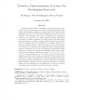Free Online Productivity Tools
i2Speak
i2Symbol
i2OCR
iTex2Img
iWeb2Print
iWeb2Shot
i2Type
iPdf2Split
iPdf2Merge
i2Bopomofo
i2Arabic
i2Style
i2Image
i2PDF
iLatex2Rtf
Sci2ools
ARSCOM
2007
2007
Towards a Characterisation of Lottery Set Overlapping Structures
Consider a lottery scheme consisting of randomly selecting a winning t–set from a universal m–set, while a player participates in the scheme by purchasing a playing set of any number of n–sets from the universal set prior to the draw, and is awarded a prize if k or more elements of the winning t–set occur in at least one of the player’s n–sets (1 ≤ k ≤ {n, t} ≤ m). This is called a k–prize. The player may wish to construct a playing set, called a lottery set, which guarantees the player a k–prize, no matter which winning t–set is chosen from the universal set. The cardinality of a smallest lottery set is called the lottery number, denoted by L(m, n, t; k), and the number of such non–isomorphic sets is called the lottery characterisation number, denoted by η(m, n, t; k). In this paper an exhaustive search technique is employed to characterise minimal lottery sets of cardinality not exceeding six, within the ranges 2 ≤ k ≤ 4, k ≤ t ≤ 11, k ≤ n ≤ 12...
| Added | 08 Dec 2010 |
| Updated | 08 Dec 2010 |
| Type | Journal |
| Year | 2007 |
| Where | ARSCOM |
| Authors | Alewyn P. Burger, W. R. Grundlingh, Jan H. van Vuuren |
Comments (0)

